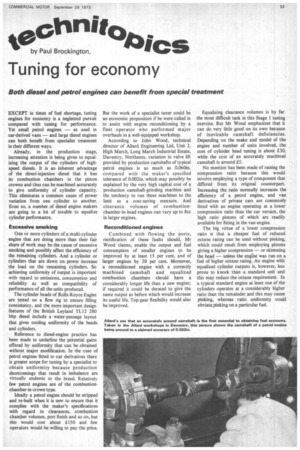t ee t nito Abi a Cs
Page 55

If you've noticed an error in this article please click here to report it so we can fix it.
Tuning for economy
Both diesel and petrol engines can benefit from special treatment
EXCEPT in times of fuel shortage, tuning engines for economy is a neglected pursuit compared with tuning for performance. Yet small petrol engines — as used in car-derived vans — and large diesel engines can both benefit from specialist treatment in their different ways.
Already, in the production stage, increasing attention is being given to equalizing the output of the cylinders of highspeed diesels. It is an inherent advantage of the direct-injection diesel that it has its combustion chambers in the piston crowns and thus can be machined accurately to give uniformity of cylinder capacity. This eliminates a common cause of power variation from one cylinder to another. Even so, a number of diesel engine makers are going to a lot of trouble to equalize cylinder performance.
Excessive smoking One or more cylinders of a multi-cylinder engine that are doing more than their fair share of work may be the cause of excessive smoking and possibly affect the efficiency of the remaining cylinders. And a cylinder or cylinders that are down on power increase the load on the remaining cylinders. So achieving uniformity of output is important with regard to emissions, consumption and reliability as well as compatibility or performance of all the units produced.
The cylinder heads of Rolls-Royce Eagles are tested on a flow rig to ensure filling consistency, and the more important design features of the British Leyland TLI2 280 bhp diesel include a water-passage layout that gives cooling uniformity of the heads and cylinders.
Reference to diesel-engine practice has been made to underline the potential gains offered by uniformity that can be obtained without major modification. In the case of petrol engines fitted to car derivatives there is greater scope for tuning by a specialist to obtain uniformity because production shortcomings that result in imbalance are virtually endemic to the breed. Relatively few petrol engines are of the combustionchamber-in-crown type.
Ideally a petrol engine should be stripped and re-built when it is new to ensure that it complies with the maker's specifications with regard to clearances, combustion chamber volumes, port finish and so on, but this would cost about £150 and few operators would be willing to pay the price. But the work of a specialist tuner could be an economic proposition if he were called in to assist with engine reconditioning by a fleet operator who performed major overhauls in a well-equipped workshop.
According to John Wood, technical director of Allard Engineering Ltd, Unit 2, High March, Long March Industrial Estate, Daventry, Northants, variation in valve lift provided by production camshafts of typical petrol engines is as much as 0.060in. compared with the maker's specified tolerance of 0.0021n. which may possibly be explained by the very high capital cost of a production camshaft-grinding machine and the tendency to run these machines to the limit as a cost-saving measure. And clearance volumes of combustionchamber-in-head engines can vary up to 8cc in larger engines.
Reconditioned engines
Combined with flowing the ports, rectification of these faults should, Mr Wood claims, enable the output and fuel consumption of smaller engines to be improved by at least 15 per cent, and of larger engines by 20 per cent. Moreover, a reconditioned engine with a correctly machined camshaft and equalized combustion chambers should have a considerably longer life than a new engine; if required it could be derated to give the same output as before which would increase its useful life. Top-gear flexibility would also be improved. Equalizing clearance volumes is by far the most difficult task in this Stage I tuning exercise. But Mr Wood emphasizes that it can do very little good on its own because of inevitable camshaft deficiencies. Depending on the make and model of the engine and number of units involved, the cost of cylinder head tuning is about £30, while the cost of an accurately machined camshaft is around £5.
No mention has been _made of raising the compression ratio because this would involve employing a type of component that differed from its original counterpart. Increasing the ratio normally increases the efficiency of a petrol engine, and van derivatives of private cars are commonly fitted with an engine operating at a lower compression ratio than the car version, the high ratio pistons of which are readily available for fitting in the van engine.
The big virtue of a lower compression ratio is that a cheaper fuel of reduced octane rating can be used without pinking, which could result from employing pistons giving a higher compression — or skimming the head — unless the engine was run on a fuel of higher octane rating. An engine with equalized cylinder outputs is, however, less prone to knock than a standard unit and this may reduce the octane requirement. In a typical standard engine at least one of the cylinders operates at a considerably higher ratio than the remainder and this may cause pinking, whereas ratio uniformity could obviate pinking on a particular fuel.












































































































